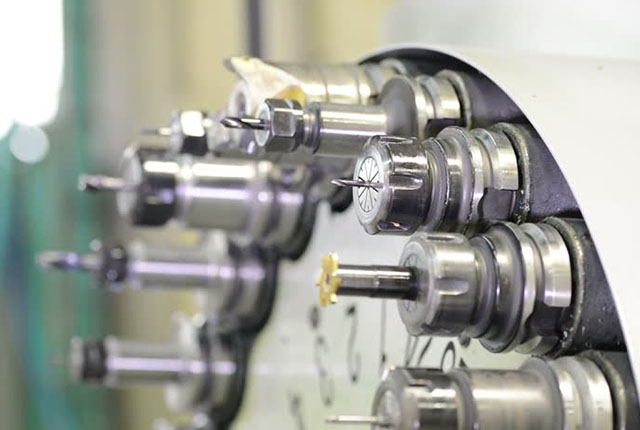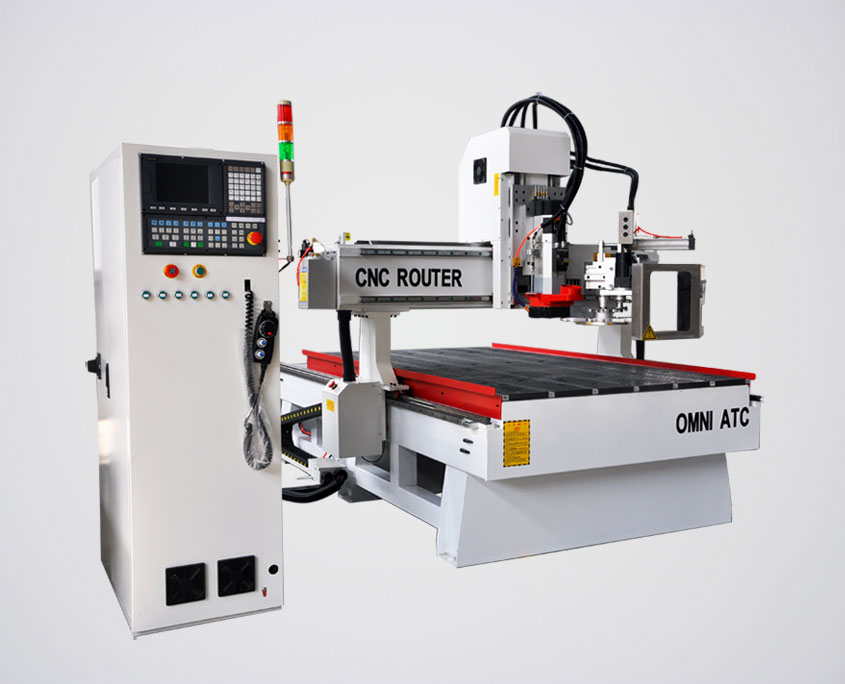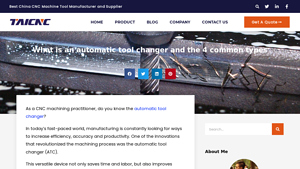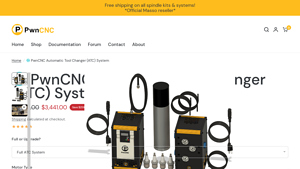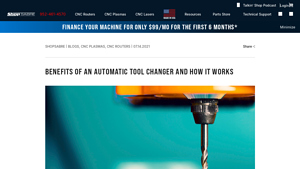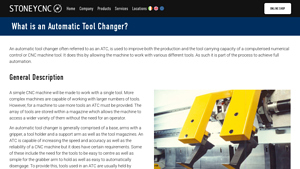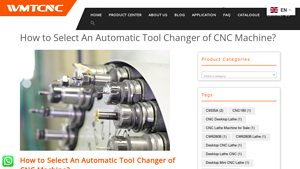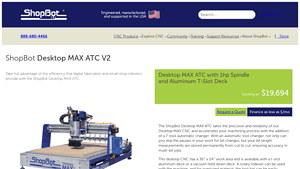Atc In Cnc Guide: Type, Cost, Top List…
Introduction: Navigating the Global Market for atc in cnc
In the competitive landscape of modern manufacturing, sourcing the right Automatic Tool Changer (ATC) for CNC applications presents a significant challenge for B2B buyers. As companies strive to enhance efficiency and precision while managing costs, understanding the diverse range of ATC options becomes crucial. This guide offers an in-depth exploration of various ATC types, including carousel, gripping, arm, and chain mechanisms, each with unique advantages tailored to different manufacturing needs.
Additionally, we delve into critical applications of ATCs across industries, enabling buyers to align their sourcing strategies with specific operational goals. The guide also emphasizes the importance of thorough supplier vetting processes to ensure quality and reliability, particularly for international buyers from regions like Africa, South America, the Middle East, and Europe, including countries such as Vietnam and Nigeria.
By providing insights into cost considerations, maintenance requirements, and technological advancements, this comprehensive resource empowers decision-makers to make informed purchasing choices. Ultimately, the guide serves as a valuable tool for businesses looking to optimize their CNC operations and remain competitive in an increasingly globalized market.
Understanding atc in cnc Types and Variations
| Type Name | Key Distinguishing Features | Primary B2B Applications | Brief Pros & Cons for Buyers |
|---|---|---|---|
| Carousel (Rotary) ATC | Horizontal circular tool magazine, limited tool storage (16-20) | Small to medium CNC machines | Pros: Cost-effective, space-saving. Cons: Longer tool change times, higher failure rates. |
| Gripping Type ATC | Front-mounted tool magazine, fast tool change (within 1 second) | CNC tapping centers | Pros: Quick tool change, low failure rate. Cons: Limited tool capacity (16-21 tools). |
| Arm Type ATC | Double-arm mechanism for simultaneous tool exchange, moderate capacity (24-30) | Vertical machining centers | Pros: Fast tool changes, versatile for various tapers. Cons: Larger footprint, prone to debris entanglement. |
| Chain Type ATC | Linear magazine with high tool capacity (60-200 tools) | Large CNC machines requiring extensive tooling | Pros: High capacity, suitable for larger tools. Cons: More complex, higher initial investment. |
| RapidChange ATC | Simplified design, cost-effective for common spindles | Hobbyist and small workshop CNC setups | Pros: Easy installation, enhances machining quality. Cons: May lack advanced features of traditional ATCs. |
What Are the Characteristics of Carousel (Rotary) ATC?
The Carousel or Rotary ATC features a horizontal circular tool magazine that rotates to access tools. With a storage capacity of 16 to 20 tools, it is ideal for small to medium CNC machines. Buyers should consider its cost-effectiveness and compact design, which can save workspace. However, the longer tool change times and relatively higher failure rates may be drawbacks, particularly for high-volume production environments.
How Does Gripping Type ATC Enhance Efficiency?
Gripping Type ATCs are characterized by their front-mounted tool magazines, allowing for rapid tool changes—often within one second. This type is commonly used in CNC tapping centers, making it suitable for operations requiring quick and efficient tool swaps. While it offers a low failure rate and is budget-friendly, its limited tool capacity can be a constraint for operations that require a wider variety of tools.
Why Choose Arm Type ATC for Vertical Machining?
The Arm Type ATC employs a double-arm mechanism that enables simultaneous tool exchanges, significantly reducing idle time. With a tool capacity of 24 to 30, it is well-suited for vertical machining centers. Its fast tool change times and adaptability to various spindle tapers make it a popular choice. However, buyers should be mindful of its larger footprint and the potential for debris entanglement, which can affect maintenance.
What Advantages Does Chain Type ATC Offer?
Chain Type ATCs utilize a linear magazine configuration, allowing for a high tool capacity ranging from 60 to 200 tools. This makes them ideal for large CNC machines that require extensive tooling. While they excel in capacity and are suitable for larger tools, the complexity of their design and the higher initial investment may deter smaller operations or those with limited budgets.
How Does RapidChange ATC Benefit Smaller Operations?
RapidChange ATCs are designed to simplify the automatic tool changing process for hobbyists and small workshops. They offer a cost-effective solution without the complexity of traditional systems, making them accessible for less experienced users. While they enhance machining quality and efficiency, buyers should consider that they might lack some advanced features found in more sophisticated ATCs, which could limit scalability for growing operations.
Key Industrial Applications of atc in cnc
| Industry/Sector | Specific Application of ATC in CNC | Value/Benefit for the Business | Key Sourcing Considerations for this Application |
|---|---|---|---|
| Aerospace | Precision component manufacturing | Enhanced accuracy and reduced production time | Compatibility with existing CNC machines and tooling |
| Automotive | Mass production of automotive parts | Increased efficiency and lower labor costs | Tool change speed and capacity to handle various tools |
| Woodworking | Custom furniture and cabinetry production | Improved flexibility and reduced setup times | Space requirements for ATC systems and tool compatibility |
| Metal Fabrication | Complex metal parts machining | Higher precision and reduced waste | Durability of components and maintenance support |
| Electronics Manufacturing | PCB fabrication and assembly | Streamlined operations and enhanced throughput | Integration with existing workflows and software support |
What Are the Key Applications of ATC in the Aerospace Sector?
In the aerospace industry, ATCs are essential for the precision manufacturing of components such as turbine blades and fuselage parts. By automating tool changes, manufacturers can achieve higher accuracy and reduce production time, critical for meeting stringent regulatory standards. Buyers in this sector should consider the compatibility of ATC systems with their existing CNC machines, as well as the types of tooling required for various aerospace applications.
How Does ATC Improve Efficiency in Automotive Manufacturing?
Automotive manufacturers benefit significantly from ATCs, particularly in the mass production of parts like engine components and chassis. The ability to quickly switch between tools minimizes downtime, thereby increasing overall efficiency and lowering labor costs. For international buyers, key considerations include the tool change speed of the ATC and its capacity to accommodate a range of tools necessary for diverse automotive applications.
What Role Does ATC Play in Woodworking Industries?
In woodworking, ATCs enable manufacturers to produce custom furniture and cabinetry with a high degree of flexibility. By reducing setup times and allowing for quick tool changes, ATCs facilitate the efficient handling of varied designs and materials. Buyers in the woodworking sector should assess the space requirements for the ATC systems and ensure compatibility with the tools they intend to use for their specific projects.
Why Is ATC Important for Metal Fabrication?
Metal fabrication relies on ATCs for the machining of complex parts with high precision, such as brackets and enclosures. The automation of tool changes helps to minimize waste and maximize throughput, which is vital in competitive markets. When sourcing ATC solutions, businesses should prioritize the durability of components and the availability of maintenance support to ensure long-term reliability.
How Does ATC Enhance PCB Fabrication in Electronics Manufacturing?
In electronics manufacturing, particularly in PCB fabrication, ATCs streamline operations by automating tool changes during various assembly processes. This results in enhanced throughput and reduced cycle times, critical for keeping pace with rapid production demands. International buyers should look for ATC systems that easily integrate with their existing workflows and provide robust software support for seamless operation.
3 Common User Pain Points for ‘atc in cnc’ & Their Solutions
Scenario 1: Long Tool Change Times Affecting Production Efficiency
The Problem: In many manufacturing facilities, long tool change times can lead to significant downtime, resulting in decreased productivity and increased operational costs. B2B buyers often find themselves in situations where their CNC machines are sitting idle while operators manually change tools, disrupting workflows and delaying project timelines. For businesses in competitive markets, this inefficiency can lead to lost contracts and dissatisfied customers.
The Solution: To combat this issue, consider investing in an efficient Automatic Tool Changer (ATC) tailored to your specific operational needs. First, evaluate the type of ATC that aligns with your machining processes, such as carousel, arm, or chain types, each offering unique advantages. For instance, arm-type ATCs generally provide faster tool change times and can handle a larger variety of tools, making them ideal for diverse machining tasks. Additionally, ensure that the ATC you choose has a robust support system for maintenance and troubleshooting. By implementing a reliable ATC, manufacturers can drastically reduce tool change times, thus maximizing machine uptime and improving overall production efficiency.
Scenario 2: High Failure Rates and Maintenance Costs
The Problem: Many businesses face the challenge of high failure rates in their automatic tool changers, leading to frequent breakdowns and costly maintenance. This issue is particularly prevalent in older or poorly maintained systems, which can result in unexpected downtime and the need for expensive repairs. B2B buyers in industries where precision and reliability are paramount must navigate the balance between cost and quality when selecting ATC solutions.
The Solution: A proactive approach to maintenance can significantly mitigate these challenges. Regular inspections and adopting a preventive maintenance schedule can help identify potential issues before they escalate. Additionally, when sourcing an ATC, prioritize suppliers that offer comprehensive warranties and support services. For instance, companies like RapidChange provide documentation and community support for troubleshooting. Furthermore, consider investing in newer ATC technologies designed with reliability in mind, such as noise-proof designs and high-quality materials, which can enhance performance and longevity. By taking these steps, businesses can reduce the frequency of failures and associated costs, leading to a more stable production environment.
Scenario 3: Limited Tool Capacity Hindering Versatility
The Problem: B2B buyers often struggle with limited tool capacity in their CNC machines, which can restrict the versatility of their operations. This limitation can be particularly problematic for businesses that require a diverse range of machining processes or need to switch between different tools frequently. As a result, companies may find themselves constrained in their ability to meet customer demands or innovate with new designs.
The Solution: To enhance versatility, consider upgrading to a more advanced ATC with a larger tool capacity. Chain-type ATCs, for instance, can accommodate 60 to 200 tools, allowing for a wider array of machining options without frequent manual tool changes. When selecting an ATC, assess your production requirements and choose a system that aligns with your long-term operational goals. Additionally, engage with suppliers who can customize solutions to fit your specific needs, ensuring that the ATC integrates seamlessly with your existing CNC setup. Implementing a robust ATC system with ample tool capacity will empower manufacturers to diversify their offerings, improve responsiveness to market changes, and ultimately drive business growth.
Strategic Material Selection Guide for atc in cnc
What Are the Key Materials for Automatic Tool Changers (ATC) in CNC Applications?
When selecting materials for Automatic Tool Changers (ATC) in CNC machining, it is essential to consider the properties, advantages, and limitations of various materials. The choice of material directly impacts the performance, durability, and overall efficiency of the ATC system. Here, we analyze four common materials used in ATC systems: aluminum, steel, polymer composites, and titanium.
How Does Aluminum Perform in ATC Systems?
Aluminum is a popular choice for ATC components due to its lightweight nature and excellent machinability. Key properties include a good strength-to-weight ratio, corrosion resistance, and the ability to withstand moderate temperatures.
Pros: Aluminum is relatively inexpensive compared to other metals, making it a cost-effective option for manufacturers. Its lightweight characteristic allows for faster tool changes, enhancing overall productivity.
Cons: However, aluminum can be less durable than steel, especially under high-stress conditions. It may also deform under excessive load, which can affect precision in tool changes.
Impact on Application: Aluminum is suitable for applications where weight reduction is critical, but it may not be the best choice for heavy-duty machining environments.
Considerations for International Buyers: Compliance with standards such as ASTM or DIN is crucial. Buyers should ensure that the aluminum used meets specific grade requirements for their applications.
What Role Does Steel Play in ATC Systems?
Steel, particularly high-carbon steel or stainless steel, is known for its exceptional strength and durability. It can withstand high temperatures and pressures, making it ideal for heavy-duty applications.
Pros: Steel’s durability ensures a long lifespan for ATC components, reducing the need for frequent replacements. It also offers excellent resistance to wear and tear, making it suitable for high-volume production environments.
Cons: On the downside, steel is heavier than aluminum, which can slow down tool change times. Additionally, it is generally more expensive to manufacture and process due to its machining complexity.
Impact on Application: Steel is particularly beneficial in environments where high precision and durability are required, such as in aerospace or automotive industries.
Considerations for International Buyers: Buyers must be aware of the specific grades of steel required for their applications, as well as compliance with international standards.
How Do Polymer Composites Enhance ATC Performance?
Polymer composites are increasingly being used in ATC systems due to their unique properties, such as lightweight, corrosion resistance, and flexibility.
Pros: These materials are highly resistant to chemicals and moisture, making them suitable for diverse machining environments. Their lightweight nature allows for faster tool changes and reduced energy consumption.
Cons: However, polymer composites may not offer the same level of durability as metals, particularly under extreme conditions. They can be more susceptible to wear and may require more frequent replacement.
Impact on Application: Polymer composites are ideal for applications where weight savings and corrosion resistance are prioritized, such as in marine or chemical processing industries.
Considerations for International Buyers: Buyers should ensure that the polymer composites used comply with relevant safety and performance standards, particularly in regions with stringent regulations.
Why Is Titanium Considered for ATC Systems?
Titanium is known for its high strength-to-weight ratio and excellent corrosion resistance, making it a premium choice for ATC components.
Pros: The primary advantage of titanium is its exceptional durability and ability to withstand harsh environments. It is also lightweight, which contributes to faster tool changes.
Cons: However, titanium is significantly more expensive than aluminum or steel, and its machining can be complex and costly.
Impact on Application: Titanium is particularly suitable for high-performance applications in industries such as aerospace and medical devices, where precision and reliability are paramount.
Considerations for International Buyers: Buyers must consider the cost implications and ensure compliance with international standards for titanium components.
Summary Table of Material Selection for ATC in CNC
| Material | Typical Use Case for ATC in CNC | Key Advantage | Key Disadvantage/Limitation | Relative Cost (Low/Med/High) |
|---|---|---|---|---|
| Aluminum | Lightweight ATC components | Cost-effective and lightweight | Less durable under high stress | Low |
| Steel | Heavy-duty ATC applications | Exceptional strength and durability | Heavier and more expensive to process | High |
| Polymer Composites | Corrosion-resistant ATC components | Lightweight and chemically resistant | Less durable under extreme conditions | Medium |
| Titanium | High-performance ATC applications | High strength-to-weight ratio | High cost and complex machining | High |
Selecting the right material for ATC systems in CNC applications is crucial for optimizing performance and ensuring longevity. By understanding the properties, advantages, and limitations of each material, international B2B buyers can make informed decisions that align with their operational needs and compliance requirements.
In-depth Look: Manufacturing Processes and Quality Assurance for atc in cnc
What Are the Key Stages in the Manufacturing Process for Automatic Tool Changers (ATC) in CNC?
The manufacturing process for Automatic Tool Changers (ATC) involves several critical stages that ensure the final product meets the necessary quality and performance standards. Understanding these stages can help B2B buyers evaluate potential suppliers and their capabilities effectively.
1. Material Preparation: What Materials Are Used in ATC Manufacturing?
The first step in the manufacturing process involves selecting high-quality materials that can withstand the rigorous demands of CNC operations. Common materials include:
- Aluminum Alloys: Lightweight yet strong, aluminum alloys are often used for the body and structural components of ATCs. They provide excellent resistance to corrosion and wear, which is crucial for longevity.
- Steel Components: For parts that require additional strength and durability, such as clamping mechanisms, high-grade steel is often employed.
- Plastics and Composites: Used in non-load-bearing components, these materials can reduce weight and cost while providing adequate performance.
After selecting the materials, they undergo cutting, machining, and surface treatment to prepare them for the next stages.
2. Forming: How Are ATC Components Shaped?
Forming processes are essential to create the various components of an ATC. Key techniques include:
- CNC Machining: Precision machining is vital for creating parts with tight tolerances, such as tool holders and mounting brackets. CNC machines ensure high accuracy and repeatability.
- Casting and Forging: For complex shapes or large components, casting or forging may be used. These processes help achieve the desired strength and shape efficiently.
- Laser Cutting and Waterjet Cutting: These methods are often employed for intricate designs, allowing for clean cuts without affecting the material properties.
The forming stage is crucial as it dictates the overall fit and functionality of the ATC components.
3. Assembly: What Is Involved in the Assembly of ATC Systems?
Once the individual components are formed, they are assembled into the complete ATC system. This stage typically involves:
- Sub-Assembly: Smaller groups of components are first assembled to create sub-assemblies, such as the tool holder or the magazine.
- Main Assembly: The sub-assemblies are then combined into the final ATC unit. This process often involves aligning components accurately to ensure smooth operation.
- Integration with CNC Machines: The assembled ATC must be integrated with the CNC machine, requiring precise alignment and calibration.
Proper assembly techniques are critical as they affect the operational efficiency and durability of the ATC.
4. Finishing: How Is the Final Product Prepared for Market?
The finishing stage enhances both the aesthetic and functional qualities of the ATC. Typical processes include:
- Surface Treatment: Coatings, anodizing, or painting may be applied to improve corrosion resistance and aesthetic appeal.
- Quality Inspection: Before moving to the next stage, each component is inspected for defects and adherence to specifications.
Finishing processes are crucial in ensuring that the ATC not only performs well but also meets the visual expectations of buyers.
What Quality Assurance Practices Are Essential for ATC Manufacturing?
Quality assurance (QA) is a cornerstone of the manufacturing process, especially for complex systems like ATCs. B2B buyers should be aware of relevant international standards and industry-specific certifications that ensure product reliability and performance.
1. What International Standards Should Buyers Be Aware Of?
Several international standards guide quality assurance practices in manufacturing, including:
- ISO 9001: This standard focuses on quality management systems and is vital for manufacturers aiming to demonstrate consistent quality in their products. Compliance with ISO 9001 indicates that a manufacturer has established processes to ensure quality at every stage of production.
- CE Marking: Particularly relevant for products sold in Europe, CE marking indicates compliance with health, safety, and environmental protection standards. It is essential for buyers in European markets.
2. What Are the Key Quality Control Checkpoints in ATC Manufacturing?
Quality control (QC) involves systematic checks at various points in the manufacturing process. Key checkpoints include:
- Incoming Quality Control (IQC): This involves inspecting raw materials and components upon arrival to ensure they meet specified standards before processing begins.
- In-Process Quality Control (IPQC): During the manufacturing process, inspections are conducted to monitor various stages of production, ensuring any issues are caught early.
- Final Quality Control (FQC): Once the ATC is fully assembled, a comprehensive inspection is carried out to ensure the unit meets all specifications and performance criteria.
These checkpoints are crucial for maintaining high-quality standards throughout the manufacturing process.
3. What Testing Methods Are Commonly Used for ATC Products?
Testing methods are integral to verifying the performance and reliability of ATCs. Common methods include:
- Functional Testing: Ensures that the ATC operates correctly under various conditions, simulating real-world scenarios.
- Durability Testing: Involves subjecting the ATC to stress tests to assess its performance under prolonged use.
- Precision Testing: Checks the accuracy of tool changes and the alignment of components.
These tests help guarantee that the ATC will perform reliably in demanding environments.
How Can B2B Buyers Verify Supplier Quality Control Practices?
For B2B buyers, especially those in Africa, South America, the Middle East, and Europe, verifying supplier quality control practices is crucial for ensuring reliable procurement.
1. What Are the Best Practices for Conducting Supplier Audits?
- On-Site Audits: Conducting on-site audits allows buyers to assess the manufacturing processes, quality control measures, and overall operational practices firsthand. This direct observation can reveal insights into the supplier’s commitment to quality.
- Reviewing Quality Documentation: Buyers should request access to quality management documents, including ISO certification, quality manuals, and inspection reports. This documentation provides a clear picture of the supplier’s quality assurance practices.
2. How Can Buyers Utilize Third-Party Inspections?
Engaging third-party inspection agencies can provide an unbiased evaluation of the supplier’s quality control practices. These agencies can conduct thorough inspections at various stages of the manufacturing process and provide detailed reports on compliance with international standards.
3. What Are the Specific QC and Certification Nuances for International Buyers?
International buyers should be aware of specific nuances related to certifications and quality control. For example, while CE marking is essential for products sold in Europe, buyers in other regions may prioritize different standards, such as UL certification in North America. Understanding these regional differences is crucial for successful procurement.
In conclusion, a thorough understanding of the manufacturing processes and quality assurance practices surrounding Automatic Tool Changers is essential for B2B buyers. By focusing on these aspects, buyers can make informed decisions, ensuring they select suppliers that meet their quality and performance expectations.
Practical Sourcing Guide: A Step-by-Step Checklist for ‘atc in cnc’
This guide is designed to assist B2B buyers in the strategic procurement of Automatic Tool Changers (ATCs) for CNC machinery. With the increasing demand for efficiency and precision in manufacturing, selecting the right ATC is crucial for enhancing productivity and reducing operational costs. Follow this step-by-step checklist to ensure a successful sourcing process.
Step 1: Define Your Technical Specifications
Clearly outline the technical requirements of your CNC operations before initiating the sourcing process. Consider factors such as the types of tools your ATC will handle, tool capacity, and compatibility with your existing machinery. This clarity will help you communicate your needs effectively to potential suppliers.
- Tool Types: Identify whether you need a carousel, gripping, arm, or chain type ATC based on your production needs.
- Capacity Requirements: Determine the number of tools you require to minimize downtime during production.
Step 2: Research Potential Suppliers
Conduct thorough research to identify reputable suppliers that specialize in ATCs. Look for companies with a proven track record in the industry and positive customer reviews.
- Supplier Background: Investigate the supplier’s history, market presence, and areas of expertise.
- Customer Feedback: Read testimonials and case studies to gauge customer satisfaction and reliability.
Step 3: Evaluate Supplier Certifications
Verify that potential suppliers possess relevant certifications and adhere to industry standards. This ensures that the ATCs you procure meet safety and quality benchmarks.
- ISO Certification: Check for ISO 9001 certification, which indicates a commitment to quality management systems.
- Compliance with Standards: Ensure compliance with international standards pertinent to your operational region.
Step 4: Assess Technical Support and Service
Evaluate the level of technical support and after-sales service offered by suppliers. Reliable support can significantly impact your operations, especially when integrating new equipment.
- Availability of Support: Confirm if the supplier provides 24/7 support and timely maintenance services.
- Training Programs: Inquire about training for your staff on the ATC operation and maintenance.
Step 5: Request and Compare Quotes
Once you have shortlisted suppliers, request detailed quotations that include pricing, delivery timelines, and warranty information. Comparing quotes will help you make an informed decision.
- Breakdown of Costs: Ensure that the quote includes all potential costs, such as installation and ongoing maintenance.
- Warranty Terms: Pay attention to warranty terms, as they can vary significantly between suppliers.
Step 6: Consider Local vs. International Suppliers
Decide whether to source from local or international suppliers based on factors like cost, lead time, and support. Local suppliers may provide faster service and easier communication, while international suppliers might offer better pricing or advanced technology.
- Logistics and Shipping: Consider the logistics involved in sourcing from overseas, including import duties and shipping times.
- Cultural Compatibility: Ensure that communication and business practices align with your company’s values and standards.
Step 7: Finalize the Purchase Agreement
Once you have selected a supplier, finalize the purchase agreement detailing all terms, including payment schedules, delivery timelines, and service commitments.
- Legal Review: Consider having a legal professional review the contract to protect your interests.
- Clear Terms: Ensure that all expectations are clearly defined to avoid misunderstandings later.
Following this checklist will guide you through the procurement process for ATCs in CNC applications, enabling you to enhance your manufacturing capabilities effectively.
Comprehensive Cost and Pricing Analysis for atc in cnc Sourcing
When considering the procurement of Automatic Tool Changers (ATCs) for CNC machines, understanding the comprehensive cost structure and pricing dynamics is critical for B2B buyers. This analysis delves into the key cost components, influential pricing factors, and strategic buyer tips tailored for international markets, particularly in Africa, South America, the Middle East, and Europe.
What Are the Key Cost Components in ATC Sourcing?
-
Materials: The quality of materials used in the manufacturing of ATCs significantly impacts the overall cost. High-grade metals, plastics, and electronic components can enhance durability and performance but may increase initial expenses.
-
Labor: Labor costs vary by region and can be influenced by local wage standards and the complexity of the ATC design. Skilled labor is necessary for the assembly and testing of ATC systems, which can drive up costs, particularly in developed markets.
-
Manufacturing Overhead: This includes costs related to utilities, facility rent, and equipment maintenance. Efficient manufacturing processes can help mitigate these overheads, but they still play a substantial role in pricing.
-
Tooling: Custom tooling required for specific ATC designs can add to the initial investment. Buyers should consider whether the supplier has the necessary tooling capabilities to avoid additional costs later.
-
Quality Control (QC): Rigorous QC processes ensure that ATCs meet specified performance standards. While these processes incur costs, they are essential for maintaining product reliability and minimizing returns or failures.
-
Logistics: Transportation and shipping costs, especially for international buyers, can significantly affect pricing. Factors like shipping distance, mode of transport, and local customs regulations should be factored into the total cost.
-
Margin: Suppliers will typically include a margin that accounts for profit, risk, and market conditions. This margin can vary widely based on the supplier’s reputation and market demand.
What Influences Pricing for ATCs in CNC Sourcing?
-
Volume/MOQ (Minimum Order Quantity): Higher order volumes often lead to lower per-unit costs due to economies of scale. Buyers should negotiate terms that maximize their purchasing power.
-
Specifications and Customization: Customized ATCs tailored to specific machining needs can result in higher prices. Buyers should carefully assess their requirements to balance cost and functionality.
-
Material Quality and Certifications: ATCs made from certified materials or those that comply with international standards often come at a premium but provide assurance of quality and reliability.
-
Supplier Factors: The reputation and track record of the supplier can influence pricing. Established suppliers may charge more due to their reliability and after-sales support.
-
Incoterms: Understanding Incoterms (International Commercial Terms) is crucial as they dictate the responsibilities of buyers and sellers in terms of shipping, insurance, and tariffs. This can significantly affect the total landed cost of the ATC.
What Are the Best Buyer Tips for Cost-Efficient ATC Procurement?
-
Negotiate Strategically: Leverage relationships with suppliers to negotiate better terms. Presenting a clear understanding of your needs and market conditions can lead to favorable pricing.
-
Consider Total Cost of Ownership (TCO): Beyond the purchase price, evaluate maintenance, operational efficiency, and potential downtime costs. A higher initial investment in a quality ATC may yield long-term savings.
-
Understand Pricing Nuances for International Markets: Buyers from regions like Africa, South America, and the Middle East should account for potential import tariffs, local taxes, and currency fluctuations when budgeting for ATC purchases.
-
Research Supplier Options: Diversifying supplier options can provide leverage in negotiations and potentially reveal better pricing or more suitable products.
-
Stay Informed on Market Trends: Regularly monitoring market trends, such as advancements in ATC technology or shifts in raw material costs, can inform better purchasing decisions.
Disclaimer on Pricing
It is essential to note that prices for ATCs can vary widely based on the factors mentioned above. Buyers are encouraged to obtain multiple quotes and conduct thorough due diligence to ensure they are making informed purchasing decisions.
Alternatives Analysis: Comparing atc in cnc With Other Solutions
Exploring Alternatives to ATC in CNC Systems
In the ever-evolving landscape of manufacturing and machining, businesses are continually seeking innovative solutions to enhance productivity, efficiency, and accuracy. While Automatic Tool Changers (ATCs) are widely recognized for their ability to automate tool changes, it’s essential to consider alternative solutions that may also fulfill specific operational needs. This section explores various alternatives, comparing them against ATCs to provide B2B buyers with actionable insights for informed decision-making.
| Comparison Aspect | Atc In Cnc | Manual Tool Change | Robotic Arm Tool Change |
|---|---|---|---|
| Performance | High-speed tool changes; reduces idle time | Slower; manual errors possible | Very high-speed; versatile in tasks |
| Cost | Mid to high initial investment; lower long-term costs | Low initial cost; high labor costs | High initial investment; high ROI potential |
| Ease of Implementation | Requires integration with CNC systems | Simple to implement; no tech needed | Complex; requires programming and setup |
| Maintenance | Moderate; depends on type and usage | Low; minimal maintenance required | High; requires regular servicing and calibration |
| Best Use Case | High-volume production; complex machining tasks | Low-volume jobs; simple tasks | Multi-tasking environments; flexible production |
Detailed Breakdown of Alternatives
Manual Tool Change
Manual tool changing involves operators physically swapping tools based on production requirements. This method is cost-effective initially, as it requires no advanced technology or integration with CNC systems. However, the performance is limited due to potential human error, slower changeover times, and increased labor costs over time. This approach is best suited for low-volume production environments where simplicity and cost are prioritized over efficiency.
Robotic Arm Tool Change
Robotic arms equipped with tool changing capabilities represent a sophisticated alternative to ATCs. These systems offer exceptional speed and versatility, capable of handling various tasks beyond just tool changes, such as assembly or packaging. Although the initial investment is substantial, the potential for high returns in high-volume and diverse production settings makes it an attractive option. However, the complexity of implementation and the need for regular maintenance can be a drawback for smaller operations.
Conclusion: Choosing the Right Solution for Your Needs
When evaluating whether to implement an ATC or consider alternative solutions like manual tool changes or robotic arms, B2B buyers should carefully assess their specific operational requirements, production volume, and budget constraints. For high-volume, precision-demanding tasks, ATCs offer significant advantages in performance and long-term cost efficiency. In contrast, manual tool changes may suffice for smaller operations with less frequent tool swaps, while robotic arms provide a flexible, albeit complex, solution for manufacturers looking to innovate across multiple processes. Ultimately, the right choice hinges on aligning the technology with the strategic goals of the business.
Essential Technical Properties and Trade Terminology for atc in cnc
What Are the Key Technical Properties of Automatic Tool Changers (ATC) in CNC?
Understanding the technical specifications of Automatic Tool Changers (ATCs) is essential for B2B buyers looking to enhance their CNC machining capabilities. Here are some critical specs to consider:
1. Tool Capacity
Tool capacity refers to the number of tools an ATC can hold. This specification is crucial for determining the versatility of the machining process. A higher tool capacity allows for a broader range of operations without manual intervention, thus increasing productivity. For example, a carousel ATC may hold 16-20 tools, while a chain type can accommodate 60-200 tools. Choosing the right capacity depends on your specific machining needs and production volume.
2. Tool Change Time
Tool change time is the duration it takes for the ATC to switch from one tool to another. This metric directly impacts machine downtime and overall efficiency. Typical change times can range from less than one second for gripping type ATCs to a few seconds for arm type changers. Businesses should prioritize ATCs with shorter change times to maximize operational throughput and minimize idle time.
3. Material Grade
The material grade of the ATC components, such as the tool holders and arms, affects durability and performance. High-grade materials like aluminum alloys or hardened steel are often preferred due to their strength and resistance to wear. Selecting an ATC with robust material can lead to lower maintenance costs and extended service life, which is particularly beneficial for companies operating in high-demand environments.
4. Compatibility with CNC Machines
Compatibility encompasses the types of CNC machines the ATC can be integrated with. This includes considerations for spindle taper types (e.g., BT40, BT50) and motion controllers. Ensuring that the ATC is compatible with existing machinery reduces installation costs and downtime. Buyers should always verify compatibility to streamline operations and avoid costly modifications.
5. Electrical Requirements
Understanding the electrical specifications, such as voltage and current ratings, is vital for ensuring safe and efficient operation. An ATC with high power requirements may necessitate additional electrical infrastructure. Properly assessing electrical needs can prevent operational disruptions and enhance safety in the manufacturing environment.
What Are Common Trade Terms Used in the ATC Industry?
Familiarity with industry jargon is essential for effective communication and negotiation in the ATC market. Here are several common terms:
1. OEM (Original Equipment Manufacturer)
OEM refers to a company that produces parts or equipment that may be marketed by another manufacturer. In the context of ATCs, an OEM might supply the tool changers to CNC machine manufacturers. Understanding OEM relationships helps buyers evaluate quality and support options.
2. MOQ (Minimum Order Quantity)
MOQ is the smallest quantity of a product that a supplier is willing to sell. Knowing the MOQ is crucial for budget planning and inventory management. Buyers must assess whether they can meet the MOQ to avoid overstocking or incurring higher costs.
3. RFQ (Request for Quotation)
An RFQ is a formal document that solicits price offers from suppliers. This process allows buyers to compare costs and specifications from multiple vendors, ensuring they receive the best value for their investment in ATC systems.
4. Incoterms (International Commercial Terms)
Incoterms are a set of rules that define the responsibilities of buyers and sellers in international transactions. Familiarity with these terms helps B2B buyers understand shipping costs, risk transfer, and delivery obligations, which is essential for effective supply chain management.
5. Lead Time
Lead time refers to the time it takes from placing an order to receiving the product. Understanding lead times is crucial for project planning and inventory management, as longer lead times can impact production schedules.
By grasping these technical properties and industry terms, B2B buyers can make informed decisions when selecting Automatic Tool Changers for their CNC operations, ultimately leading to improved efficiency and productivity in their manufacturing processes.
Navigating Market Dynamics and Sourcing Trends in the atc in cnc Sector
What Are the Key Market Drivers for ATC in the CNC Sector?
The Automatic Tool Changer (ATC) market in the CNC sector is witnessing significant growth driven by increasing automation in manufacturing processes. This trend is particularly pronounced in emerging markets across Africa, South America, the Middle East, and Europe. The demand for greater efficiency, precision, and reduced labor costs is prompting manufacturers to invest in advanced CNC machinery equipped with ATCs. Additionally, as industries evolve, there is a shift towards lean manufacturing practices, which emphasize minimizing waste and optimizing productivity.
Current sourcing trends indicate a growing preference for modular and flexible ATC systems that can easily integrate with existing CNC setups. For instance, manufacturers are increasingly considering plug-and-play solutions that reduce installation time and costs. Innovations such as the RapidChange ATC system are gaining traction due to their simplicity and effectiveness, catering to both large-scale manufacturers and small workshops. Furthermore, the rise of Industry 4.0 technologies is facilitating real-time monitoring and predictive maintenance, enhancing the overall efficiency of ATC systems.
How Are Sustainability and Ethical Sourcing Shaping the ATC Market?
Sustainability is becoming a crucial factor in B2B sourcing decisions, especially for international buyers. The environmental impact of manufacturing processes, including those involving ATCs, is under scrutiny. As a result, companies are increasingly seeking suppliers who prioritize eco-friendly practices. This includes using sustainable materials and minimizing waste throughout the production lifecycle.
Ethical sourcing is also gaining importance as businesses recognize the need for transparency in their supply chains. Buyers are looking for manufacturers that adhere to ethical labor practices and demonstrate a commitment to corporate social responsibility. Certifications such as ISO 14001 for environmental management systems and adherence to sustainable sourcing standards are becoming key differentiators. Suppliers who can showcase their commitment to sustainability and ethical practices are likely to gain a competitive edge in the global market.
What Is the Historical Evolution of ATC Technology in CNC Machining?
The evolution of ATC technology can be traced back to the early days of CNC machining when manual tool changes limited production efficiency. Initial designs focused on simple mechanical systems, which gradually evolved into more sophisticated automated solutions. By the late 20th century, the introduction of computer controls enabled faster and more reliable tool changes, paving the way for the development of various ATC types, such as carousel, arm, and chain systems.
Today, ATC technology continues to advance with innovations aimed at enhancing speed, reliability, and flexibility. The integration of smart technologies and IoT capabilities into ATC systems is transforming how manufacturers approach machining processes, making them more adaptable to changing production demands. This historical context underscores the importance of staying abreast of technological advancements for B2B buyers looking to optimize their CNC operations.
Frequently Asked Questions (FAQs) for B2B Buyers of atc in cnc
-
How do I choose the right automatic tool changer (ATC) for my CNC machine?
When selecting an ATC, consider your machining needs, including tool capacity, change speed, and compatibility with your CNC machine. Evaluate the types of ATCs available—carousel, gripping, arm, and chain—based on your production volume and space constraints. Additionally, assess factors such as cost, maintenance requirements, and the complexity of installation. Ensure that the ATC aligns with your specific applications, whether it’s milling, turning, or multitasking, to maximize efficiency and productivity. -
What is the best automatic tool changer type for high-volume production?
For high-volume production, a chain-type automatic tool changer is often the best choice. With the capacity to hold 60 to 200 tools, it minimizes downtime by allowing quick tool changes and accommodating a wide variety of tools. This type is particularly advantageous in environments where multiple machining operations are performed consecutively. However, ensure that your CNC machine is compatible with this type of ATC, as it requires adequate space and structural support. -
What are the key benefits of using an ATC in CNC machining?
Implementing an ATC in your CNC machining process offers significant advantages, including reduced cycle times and improved precision. By automating tool changes, manufacturers can minimize human error, enhance productivity, and maintain consistent quality. Additionally, ATCs contribute to safer working conditions by reducing manual handling of tools, which can lead to workplace injuries. Overall, investing in an ATC can lead to greater operational efficiency and profitability. -
What factors should I consider when vetting suppliers for ATC systems?
When evaluating suppliers for ATC systems, consider their industry experience, product quality, and customer support. Look for suppliers with a proven track record and positive reviews from previous clients. Assess their ability to provide customization options to meet your specific needs and check their certifications for quality assurance. Additionally, inquire about their after-sales service, warranty policies, and availability of spare parts to ensure long-term support for your investment. -
What are typical minimum order quantities (MOQs) for ATC systems?
Minimum order quantities for ATC systems can vary significantly among suppliers, often ranging from one unit for niche manufacturers to larger quantities for bulk orders. It’s essential to discuss your specific requirements with potential suppliers to determine their MOQs. Additionally, some suppliers may offer flexibility for smaller businesses or startups, allowing you to negotiate terms that fit your budget while still gaining access to high-quality products. -
What payment terms should I expect when purchasing ATC systems internationally?
Payment terms for international purchases of ATC systems typically include options like wire transfers, letters of credit, or PayPal for smaller transactions. Standard terms might require a deposit (often 30% to 50%) upfront, with the remainder due before shipping or upon delivery. Always ensure to clarify payment terms before finalizing the order, and consider the implications of currency fluctuations and transaction fees when dealing with international suppliers. -
How can I ensure quality assurance (QA) for my ATC system?
To ensure quality assurance for your ATC system, request detailed documentation of the manufacturing process, including quality control measures and testing protocols. Reputable suppliers will provide certifications that demonstrate compliance with international standards. Additionally, consider conducting a pre-shipment inspection or quality audit, especially for large orders, to verify that the systems meet your specifications and performance requirements before they are shipped. -
What logistics considerations should I keep in mind when sourcing ATC systems?
When sourcing ATC systems, logistics considerations are crucial to ensure timely delivery and minimize costs. Evaluate shipping options, including air freight for speed and sea freight for cost-effectiveness, depending on your timeline. Additionally, assess customs regulations and duties in your country, as these can impact overall costs. It’s also wise to collaborate with suppliers who have experience in international shipping to navigate potential challenges and ensure smooth delivery.
Important Disclaimer & Terms of Use
⚠️ Important Disclaimer
The information provided in this guide, including content regarding manufacturers, technical specifications, and market analysis, is for informational and educational purposes only. It does not constitute professional procurement advice, financial advice, or legal advice.
While we have made every effort to ensure the accuracy and timeliness of the information, we are not responsible for any errors, omissions, or outdated information. Market conditions, company details, and technical standards are subject to change.
B2B buyers must conduct their own independent and thorough due diligence before making any purchasing decisions. This includes contacting suppliers directly, verifying certifications, requesting samples, and seeking professional consultation. The risk of relying on any information in this guide is borne solely by the reader.
Top 7 Atc In Cnc Manufacturers & Suppliers List
1. LVCNC – Automatic Tool Changer (ATC)
Domain: lvcnc.com
Registered: 2013 (12 years)
Introduction: Automatic Tool Changer (ATC) is a device used in manufacturing to automatically change tools during production without human intervention. It significantly speeds up production, reduces errors, and increases precision. There are four common types of ATCs: 1. Carousel (or Rotary) ATC: – Tool capacity: 16 to 20 tools – Compact design – Suitable for small to medium CNC machines – Advantages: cheap pr…
2. PwnCNC – Automatic Tool Changer (ATC) System
Domain: pwncnc.com
Registered: 2019 (6 years)
Introduction: Product Name: PwnCNC Automatic Tool Changer (ATC) System
Price: $3,441.00 (Full ATC System / 2.2kw 220v)
Variants:
– Full ATC System / 1.5kw 110v – $3,348.00
– Upgrade from existing Spindle System / 2.2kw 220v – $2,697.00
– Upgrade from existing Spindle System / 1.5kw 110v – $2,604.00
Motor Types:
– 2.2kw 220v
– 1.5kw 110v
Features:
– Fully Bench-Tested
– Plug-n-Play Experience
– Noise-Proof Desi…
3. ShopSabre – IS-A and IS-M Series CNC Routers
Domain: shopsabre.com
Registered: 2002 (23 years)
Introduction: IS-A Series CNC Router: Starting at $99,995.00, designed for industrial and commercial use, features auto unload for high efficiency nested based sheet processing. IS-M Series CNC Router: Starting at $57,995.00, known as the world’s fastest and most accurate CNC control, suitable for industrial and commercial use with dedicated high production and high accuracy. Industrial Series (IS) Machine: Sta…
4. Gizin – Automatic Tool Changers (ATC)
Domain: gizin-atc.com
Registered: 2021 (4 years)
Introduction: Automatic Tool Changers (ATC) are devices used in automation and robotics to facilitate the quick exchange of tools. They come in various types, including: 1. Pneumatic ATC – uses compressed air for operation. 2. Electric ATC – operates using electric motors. 3. Hydraulic ATC – utilizes hydraulic fluid for movement. Advantages of ATC include increased efficiency, reduced downtime, and enhanced pre…
5. Stoney CNC – Automatic Tool Changer (ATC)
Domain: stoneycnc.co.uk
Registered: 2013 (12 years)
Introduction: An automatic tool changer (ATC) is used to enhance the production and tool carrying capacity of CNC machines by allowing them to work with multiple tools. It consists of a base, arms with a gripper, a tool holder, a support arm, and tool magazines. ATCs can be rotary holders or static racks, and high-end machines may have chain-type tool holding stations. The ATC increases speed, accuracy, and rel…
6. CNCWMT – Automatic Tool Changer (ATC)
Domain: cncwmt.com
Registered: 2018 (7 years)
Introduction: Automatic Tool Changer (ATC) is used in CNC machine tools to enhance production and tool carrying capacity. Key advantages include: reduced tool changing time, high tool repeating positioning accuracy, sufficient tool storage capacity, compact structure for easy manufacturing and maintenance, reasonable layout, improved rigidity to minimize impact, vibration, and noise, and chip-proof and dust-pro…
7. ShopBot – Desktop MAX ATC CNC
Domain: shopbottools.com
Registered: 1996 (29 years)
Introduction: Product Name: ShopBot Desktop MAX ATC CNC
Starting Price: $19,694
Features:
– 1HP Automatic tool change spindle with pneumatically actuated draw bar
– 7 position tool bar with 7 ISO20 tool holders compatible with ER20 collets (up to 1/2″ shank)
– Requires compressed air (4 scfm at 90 psi recommended)
– Solid machined aluminum frame with pinned/bolted joints
– Aluminum T-slot and Vacuum deck option…
Strategic Sourcing Conclusion and Outlook for atc in cnc
As the CNC industry continues to evolve, the integration of Automatic Tool Changers (ATCs) represents a pivotal advancement in manufacturing efficiency and precision. Key takeaways for international B2B buyers include the recognition of ATCs as essential components that not only streamline production processes but also enhance safety and reduce operational downtime. By carefully considering the type of ATC—whether Carousel, Gripping, Arm, or Chain—buyers can strategically align their sourcing decisions with their specific operational needs and budget constraints.
The value of strategic sourcing cannot be overstated; it is a critical factor in optimizing supply chains and ensuring that businesses remain competitive in a global marketplace. By investing in high-quality ATC solutions, companies can maximize their production capabilities, ultimately leading to improved profitability and customer satisfaction.
Looking ahead, the demand for innovative and efficient machining solutions will only grow. International buyers from regions such as Africa, South America, the Middle East, and Europe should seize this opportunity to enhance their operations. By leveraging the advancements in ATC technology, businesses can position themselves at the forefront of the manufacturing landscape. Engage with suppliers today to explore how ATCs can transform your CNC operations and drive sustainable growth.
